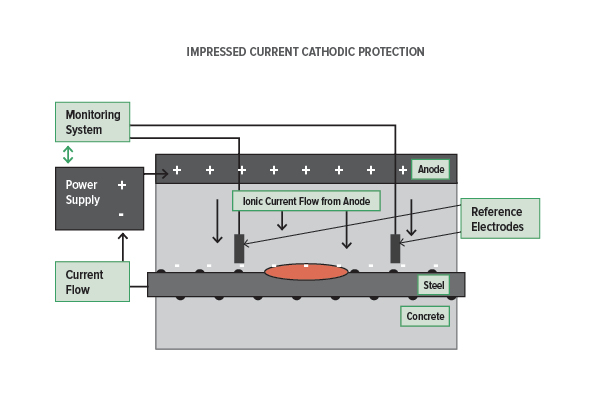Impressed current cathodic protection (ICCP) systems consist of an anode system, a DC power supply and monitoring probes, with associated wiring as with other cathodic protection systems. For steel in concrete, one of the most important decisions is the choice of anode.

Anodes consist of:
- conductive coatings on the surface (conductive organic coatings, thermal sprayed zinc or titanium)
- mixed metal oxide coated titanium mesh or ladders in a concrete overlay
- conductive mortar overlays
- coated titanium ribbon in slots
- conductive ceramics or mixed metal oxide coated titanium rods or tubes in holes in the concrete
The range of anodes means that the technology can be adapted for application to most situations. There is extensive literature on the subject as well as national and international standards and specifications. ICCP has been applied to most types of reinforced concrete structures, such as:
- Buildings (blocks of flats, offices, hospitals, schools etc.)
- Bridges (decks and substructures)
- Tunnels
- Wharves and jetties
- Water towers
- Industrial plant
- Multistorey car parks
It is primarily applied to structures suffering from
- Cast in chlorides (contaminants or calcium chloride admixture)
- Sea salt ingress on marine structures
- Deicing salt on highway structures
- Historic steel framed, stone clad structures
Cathodic protection stops the corrosion process across the whole of the area where anodes are applied. It is extremely versatile and is not limited by the extent and severity of corrosion, as long as anodes can be placed in a suitable electrolyte for the current to pass to the corroding steel areas.
Using cathodic protection:
- minimises the amount of break out for patch repairs
- smaller cut outs may alleviate the need for structural propping during patch repairs
- minimising patch repairs minimised the disturbance to occupants of offices, blocks of flats etc.
- provides continuous information showing that the system is protecting the structure
- is frequently the most cost effective solution on a whole life cost analysis
- provides protection regardless of chloride levels
- Can be provided with insurance backed warranty
Galvanic Cathodic Protection
Uses zinc or aluminium to corrode preferentially and protect the steel. Anodes consist of:
- Thermal sprayed zinc or aluminium alloy on the concrete surface
- Small potted zinc anodes in repairs or cored holes
- Zinc mesh in a permanent grp jacket
- Zinc sheet with a conductive adhesive
Galvanic cp requires no power or monitoring but cannot be controlled, has indeterminate life and cannot guarantee protection
What we can do for you
- Review the condition of your structure
- Recommend repair options
- Impressed current cathodic protection
- Galvanic cathodic protection
- Provide designs and performance specifications
- Provide lists of qualified and experienced contractors
More information can be found in the latest edition of my book. Details for ordering are on the Books and Reports page of the website.
The European and International standard BS EN ISO 12696:2012 covers impressed current and galvanic cathodic protection of steel in concrete that is atmospherically exposed, buried and submerged (see Home Page NEWS). NACE also has standards and reports on these subjects separately as well as test methods for impressed current anodes.
There is also more information in Corrosion Prevention Association Technical Note No 11 "Impressed Current Anodes for the cathodic protection of atmospherically exposed reinforced concrete" and other titles in the series on impressed current cathodic protection. They can all be downloaded here.